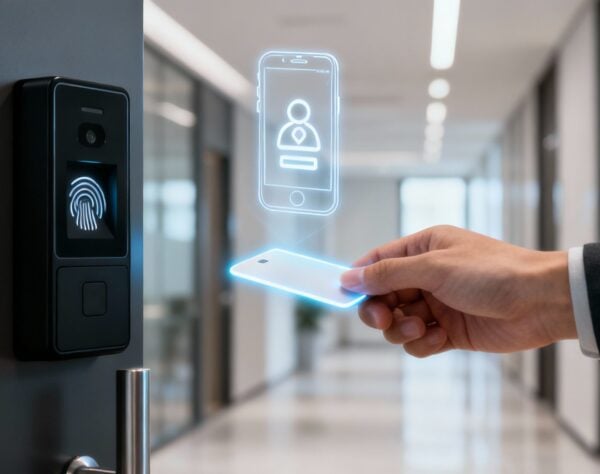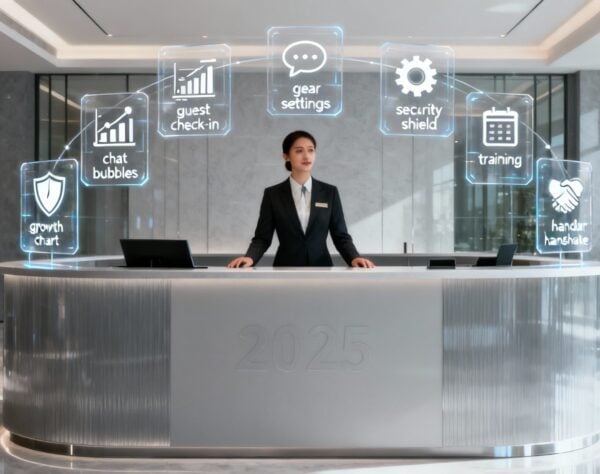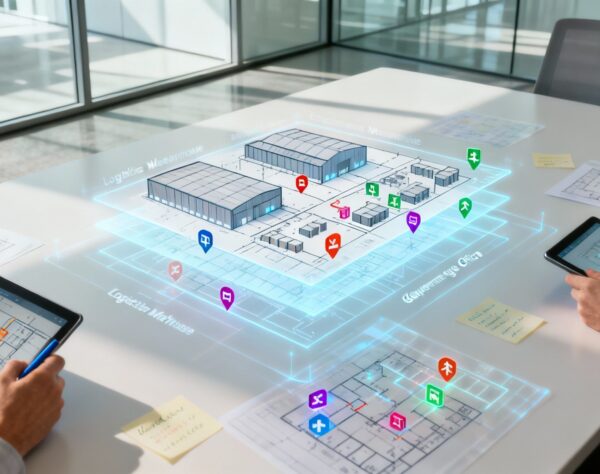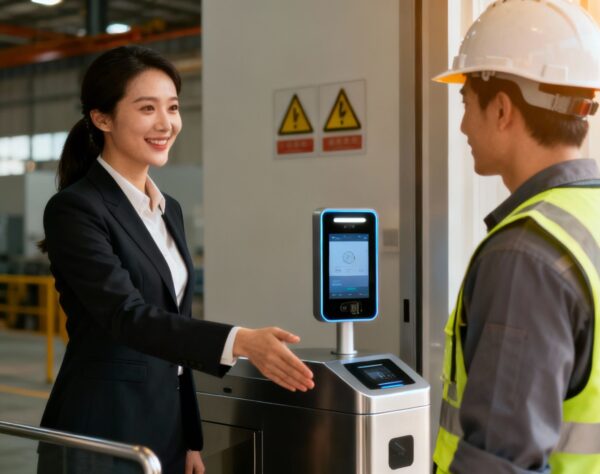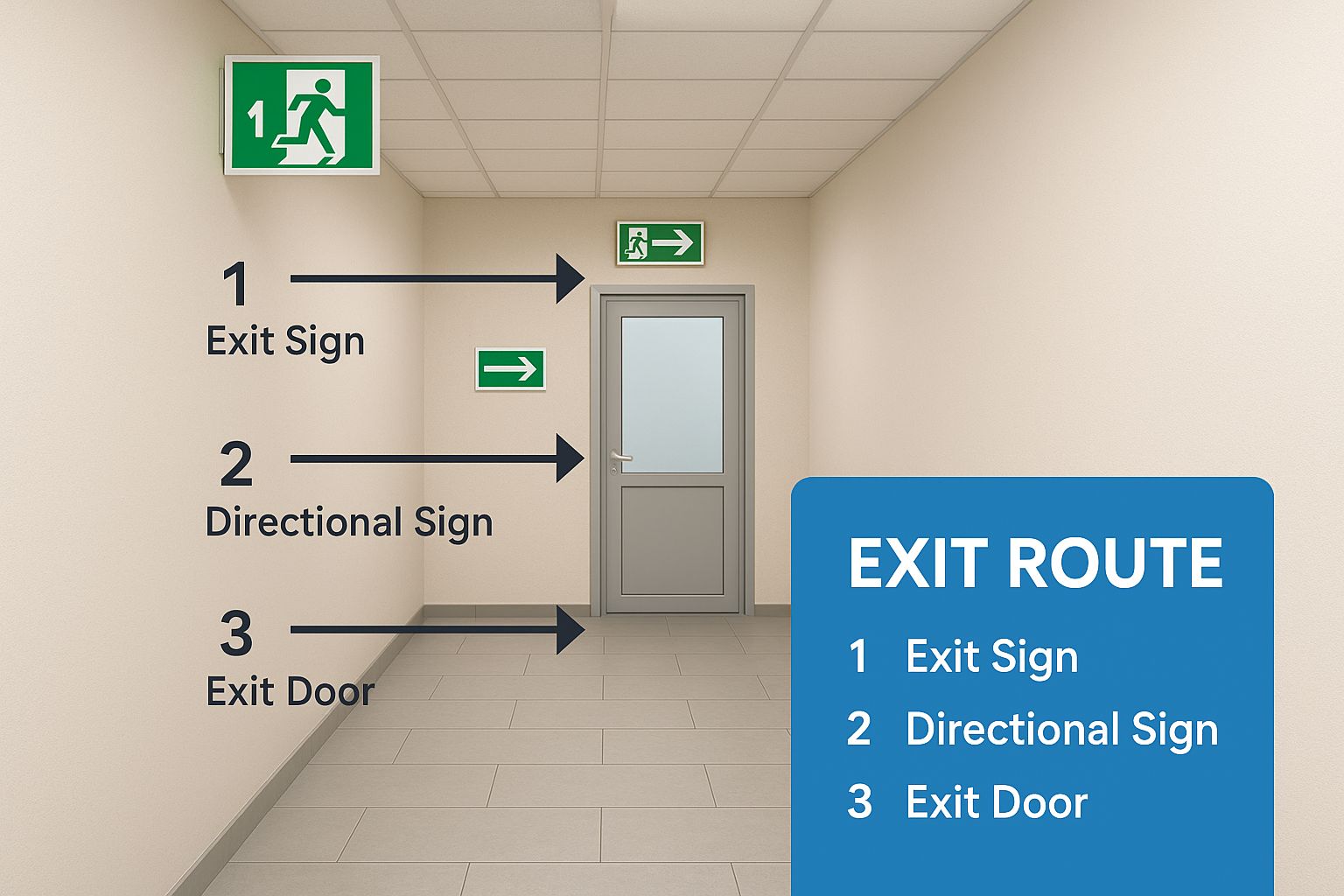
Emergency Evacuation Procedures Workplace | Safety Guide
When an emergency hits, having clear and well-practised emergency evacuation procedures workplace is the critical factor in ensuring everyone gets out safely. This isn't just about compliance; it's about building a robust safety culture where every person—from the CEO to a first-day visitor—knows exactly what to do.
Why a Clear Evacuation Plan Is Non-Negotiable
In the first moments of an alarm, chaos can take over. A solid evacuation plan is the backbone of your workplace safety, designed to turn panic into calm, purposeful action. That's why a clear plan is a non-negotiable part of your essential health and safety compliance strategies.
However, a plan on paper is not enough. Many procedures fail in a real crisis because of the gap between the documented plan and human behaviour under pressure. We've previously covered why emergency evacuation plans are so important.
Overcoming Common Preparedness Gaps
It’s easy to overlook the human element. While a map on the wall is a start, it's confidence and training that ensure people follow it during a high-stress event. Research on workplace preparedness reveals a significant gap between perceived and actual readiness.
Studies have shown that a staggering 50% of employees may not fully understand their company's emergency procedures. This hesitation can critically delay a safe evacuation.
This statistic highlights a major vulnerability. If half your team is unsure what to do, your plan's effectiveness is immediately compromised. This is where a modern approach, focused on building genuine resilience, becomes essential.
Where Traditional Evacuation Plans Often Fail
Outdated plans are riddled with gaps that can have devastating consequences. Here’s where old-school methods fall short and how the benefits of a modern system provide a life-saving upgrade.
| Common Procedural Gap | Potential Risk | Modern Solution Benefit |
|---|---|---|
| Paper Sign-In Sheets | Inaccurate, left behind in the chaos, or destroyed. | A live, cloud-based roster is accessible from any device, anywhere, guaranteeing you know who is on-site. |
| Manual Headcounts | Slow, prone to error, and impossible in large-scale evacuations. | An instant, real-time headcount of all staff, visitors, and contractors provides immediate certainty. |
| No Visitor Information | First responders don't know who they are looking for, wasting precious time. | Provides accurate names and photos to rescue teams, preventing unnecessary and dangerous searches. |
| Delayed Communication | Fire wardens can't quickly update teams or account for everyone. | Empowers fire wardens with mobile access to check people off as safe, streamlining the entire process. |
These gaps are not minor inconveniences; they represent real dangers. Closing them with modern technology isn't just an upgrade—it's a critical step in protecting your people.
The Critical Role of Real-Time Information
Traditional methods like paper sign-in books and manual roll calls are dangerously unreliable. In a real crisis, these records are often left behind, leaving first responders in the dark about who is actually inside the building. This forces rescue teams to risk their lives searching for people who may have already escaped.
This is a problem a modern visitor management system solves entirely. Instead of relying on a clipboard, you gain a real-time, cloud-based list of every person on-site—employees, contractors, and visitors. This isn't just a feature; it's a life-saving benefit. During an evacuation, a fire warden can pull up this live roster on their phone, giving first responders immediate and accurate information.
This capability fundamentally improves safety by:
- Ensuring a reliable, real-time headcount of everyone on the premises.
- Preventing anyone from being left behind with an accurate list of who to account for.
- Empowering a faster, more coordinated response by giving emergency services the exact information they need.
By bridging the gap between your plan and your people, this technology helps build a safety culture where everyone's well-being is accounted for, creating a more secure environment.
Developing A Robust Evacuation Strategy
A solid emergency evacuation procedures workplace plan is built from the ground up, starting with a serious look at your specific environment. This is about creating a resilient strategy that works when people are under pressure.
Start With a Thorough Risk Assessment
First, you must understand the real risks your workplace faces. A manufacturing plant has different dangers than a high-rise office. Consider everything from common causes—like cooking equipment, which accounts for 31% of non-residential building fires—to location-specific threats like natural disasters.
Once hazards are identified, create specific protocols for each scenario. Your plan for a chemical spill will differ vastly from your fire or security lockdown procedures. This detail separates a generic document from a plan that genuinely saves lives.
Define Clear Paths to Safety
With your risks mapped out, establish clear primary and secondary evacuation routes. These paths must be well-lit, clearly marked, and completely unobstructed—a fundamental requirement often overlooked in daily operations.
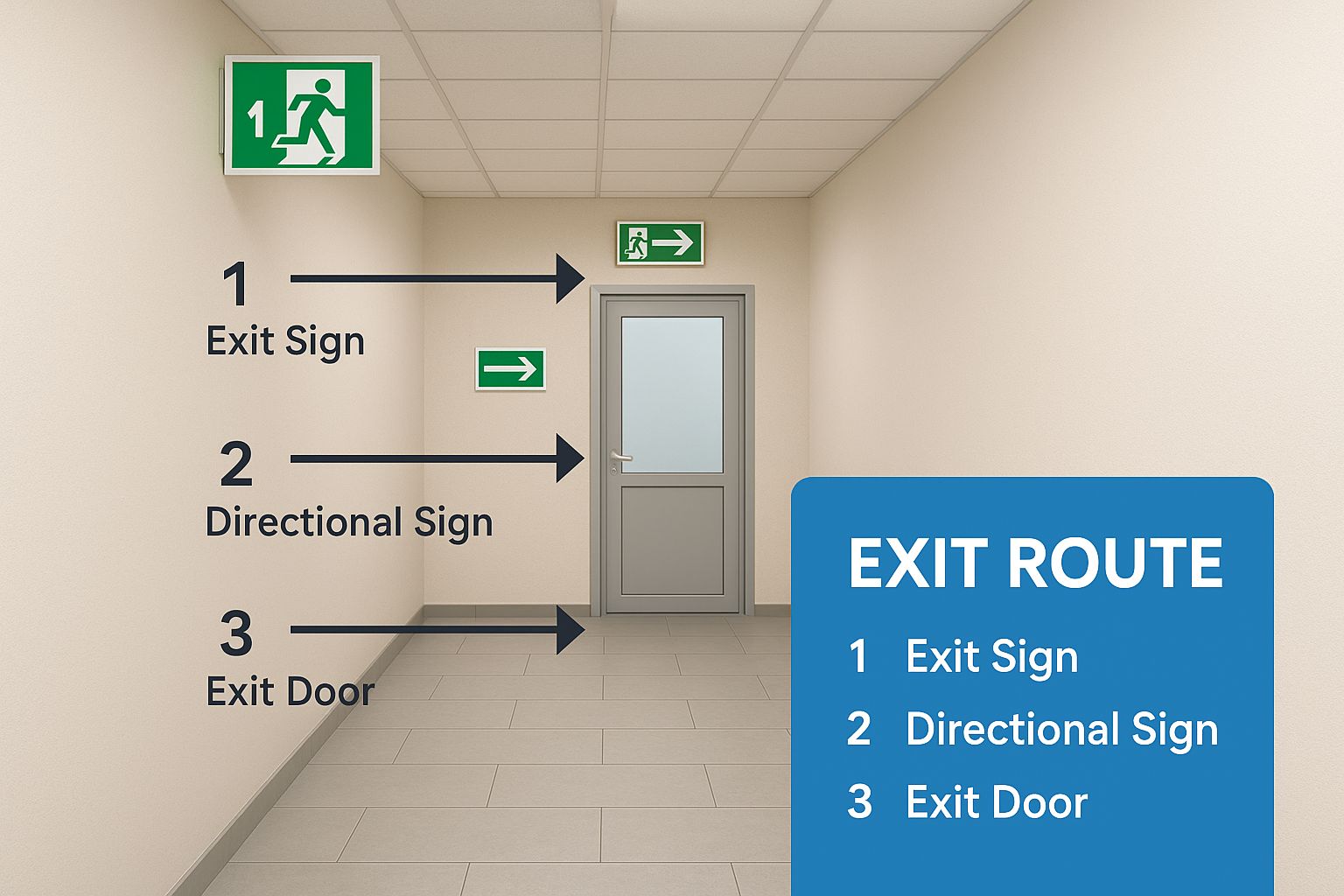
This image captures what a clear, well-marked exit route should look like. Simplicity and clarity are vital when stress is high.
Beyond routes, designate safe assembly points at a secure distance from the building where everyone gathers for a headcount.
- Primary Assembly Point: Your main, easily accessible spot, large enough for the entire team.
- Secondary Assembly Point: An essential backup in case the primary location is unsafe.
- Accessibility: Both locations must be accessible to everyone, including those with disabilities or mobility issues.
These details form the skeleton of your plan, providing the structure for an orderly evacuation.
Establish a Clear Chain of Command
In an emergency, people look for leaders. A clear chain of command is essential to prevent chaos. This means assigning specific roles and responsibilities to key team members.
A U.S. Fire Administration study revealed that fires in nonresidential buildings led to $3.3 billion in losses in just one year. A coordinated response, led by a designated team, is crucial for minimizing both human and financial costs.
Your emergency team should have key roles:
- Chief Warden: Oversees the entire operation and has the final say on ordering an evacuation.
- Floor Wardens: Responsible for clearing specific areas and reporting back to the chief warden.
- Route Guides: Positioned to direct people, ensuring routes stay clear and the evacuation remains calm.
Documenting these roles and ensuring proper training makes a coordinated response possible.
Account for Every Single Person
The biggest challenge in any evacuation is knowing if everyone got out safely. Old-school methods are slow and unreliable. This is where modern tech provides an enormous benefit.
A visitor management system gives you an instant, accurate list of every person on-site—employees, visitors, and contractors. This transforms safety by providing first responders with a real-time, digital roster instead of guesswork. This capability is so critical—you can see the difference when you manage evacuations with a modern system. It saves precious time and allows rescue teams to focus their efforts where they’re needed, ensuring no one is left behind.
Mastering Communication When It Matters Most
Clear communication is what stands between rising panic and a safe, orderly evacuation. A simple fire alarm is no longer enough. Relying on a single alert system in today's complex workplaces is a significant risk.
When an alarm sounds, people hesitate. Is it a drill? Is it real? That hesitation can be dangerous. A solid plan must cut through the confusion with instant, clear instructions.
Beyond the Bell: A Multi-Channel Approach
A robust communication strategy must accept that people receive information differently, especially under stress. To ensure your message gets through to everyone, you need a multi-channel approach. This layered strategy is key to creating dependable emergency evacuation procedures in any workplace.
- Mass Text Notifications: A direct line to everyone's pocket for critical alerts.
- Push Alerts from a Mobile App: Delivers instant notifications with maps and instructions.
- Automated PA System Announcements: Provides a calm, clear voice with more context than a siren.
- Desktop Pop-up Alerts: Grabs the attention of office-based staff by taking over their screens.
This isn't about over-complicating things; it's about redundancy. If one channel is missed, another backs it up, dramatically increasing the odds that everyone receives life-saving information.
Reaching Everyone, Everywhere
The modern workforce includes remote employees, contractors, and visitors unfamiliar with your building. This creates a huge communication challenge.
A 2021 survey highlighted this gap, finding that while 56% of remote workers preferred emergency alerts via text, many companies weren't using this channel. More concerning, only 29% of off-site employees felt they knew the proper procedures for an active shooter event. You can read more in this Security Magazine article on modern emergency preparedness.
A modern visitor management system like VisitUs solves this by acting as a central hub for emergency communications. Instead of managing separate, outdated lists, the system maintains one live record of every person on-site.
With a single action, you can send notifications across every channel. It doesn't matter if it's a new visitor, a contractor, or an employee. Everyone gets the same clear, consistent message at the same time. This ensures your duty of care covers every person on your property, turning your static safety plan into a dynamic tool that works when it counts.
Training Your Team for Real-World Scenarios
A documented plan is a good start, but people fall back on their training during an emergency. Turning your written emergency evacuation procedures workplace plan into an instinctual response is crucial.
Without regular, realistic training, even the best plan is just paper. The goal is to build genuine confidence. Prepared people are far less likely to panic and more likely to act decisively. That confidence is forged through effective drills that feel real.
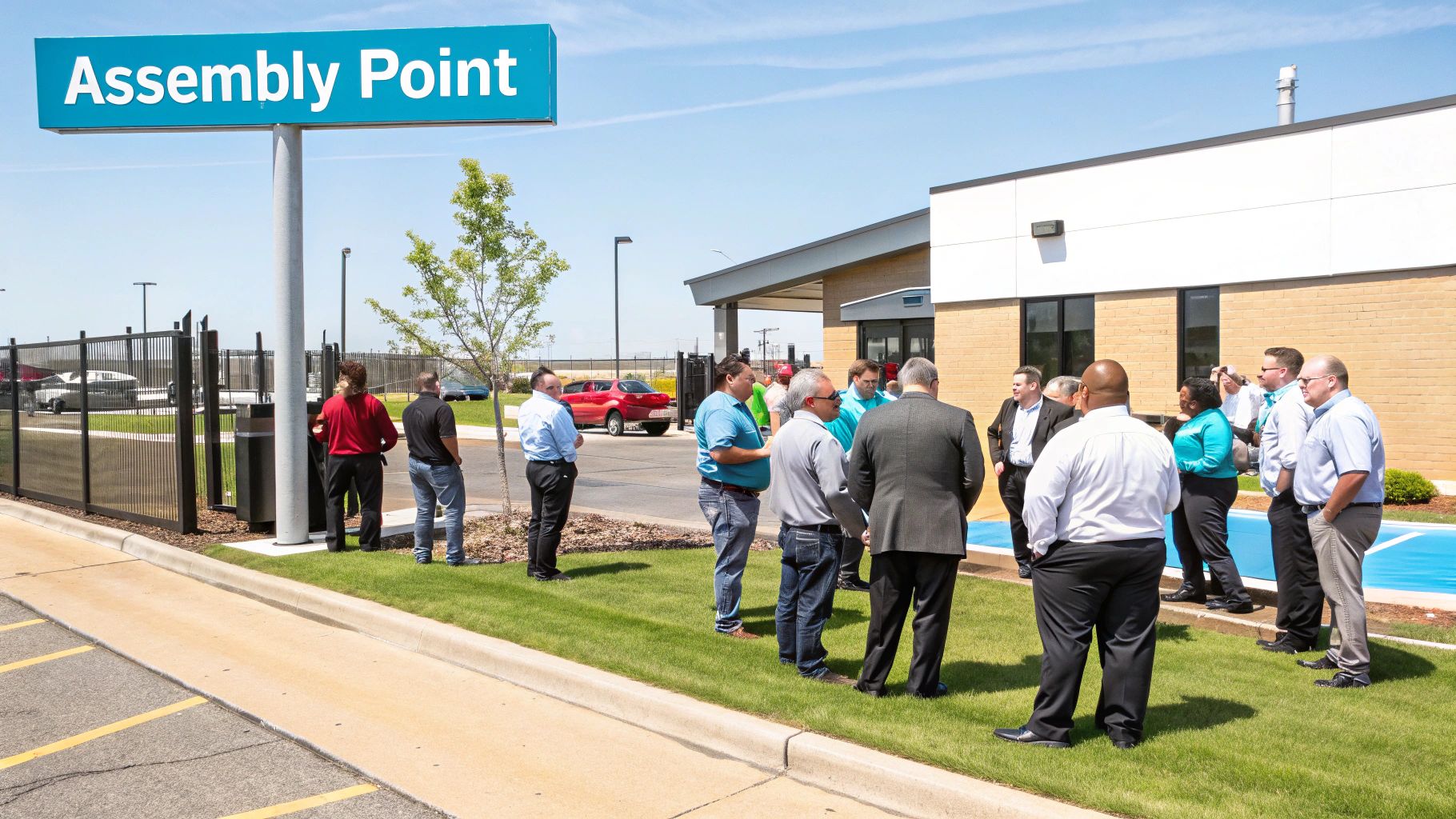
Building Confidence Through Realistic Drills
Effective drills test every part of your plan, from communication channels to the chain of command. Mixing up drill types helps build skills progressively.
-
Tabletop Exercises: Perfect for your emergency team. Walk through a specific scenario, like a fire in the server room, in a low-stress setting to identify gaps in decision-making.
-
Full-Scale Simulations: Involve the entire building and make it realistic. Not announcing the exact drill time helps gauge true reaction times and highlights where procedures need polishing.
Empowering Your Emergency Team
Your fire wardens are the backbone of your evacuation plan. They need more than a high-vis vest; they need the right training and tools to lead effectively under pressure.
Their training should cover crowd management, assisting individuals with mobility challenges, and communicating with calm authority. You can explore interactive branching safety training examples to simulate complex decisions.
The most significant upgrade you can provide your emergency team is the ability to conduct an accurate, real-time roll call. This benefit transforms a drill from a chore into a powerful, confidence-building exercise.
When your wardens are armed with a mobile app connected to your visitor management system, they can instantly account for everyone. This immediate feedback is priceless—it confirms who is safe, flags who is missing, and provides critical, real-time data to incident commanders.
From Disruption to a Powerful Safety Tool
No one likes having their workday interrupted by a drill. But with modern tools, that disruption becomes a high-value investment in your team's safety. This is where a visitor management system shines.
Instead of a chaotic manual headcount, your wardens use a mobile app. With a few taps, they see a live roster of everyone on-site—employees, visitors, and contractors. As people arrive safely, they are checked off the list. This provides an immediate, accurate picture, eliminating the guesswork and stress of wondering if someone is still inside. This capability reassures every person on your team that a reliable system is in place to ensure their safety.
Putting Technology to Work for Smarter Evacuations
In the heat of an emergency, outdated processes are a liability. Clumsy paper sign-in sheets and chaotic manual headcounts can't keep up when you need to get everyone out safely. Modern technology transforms your emergency evacuation procedures workplace plan from a checklist into a responsive, life-saving system.
This is about getting critical information to the people who need it when every second counts. Imagine handing first responders a live, cloud-based list of every person on-site. That’s a complete game-changer for workplace safety.
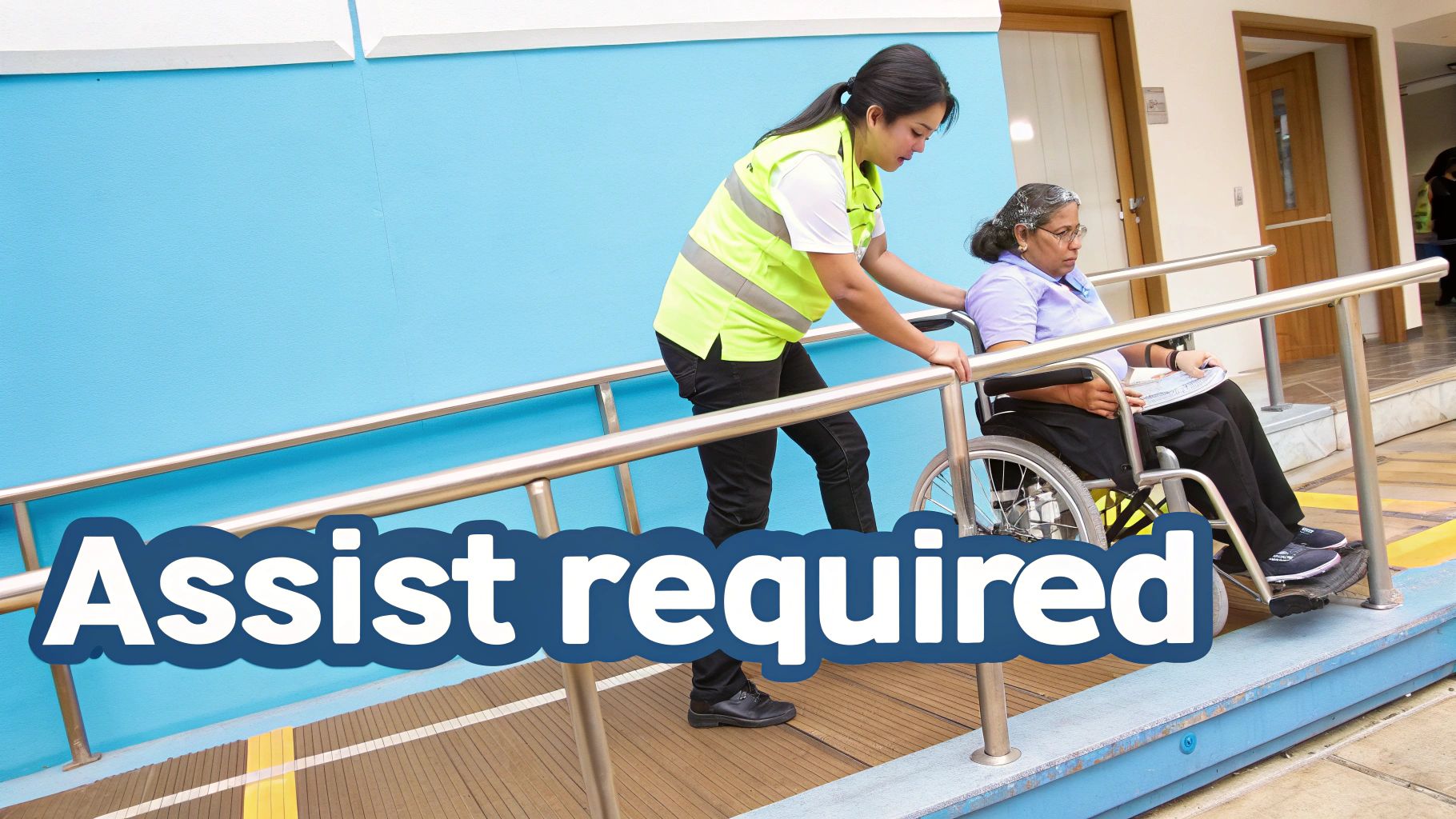
The Power of Instant Accountability
The biggest question during any evacuation is, "Is everyone out?" Getting a fast, accurate answer is the top priority. Traditional roll calls are slow, confusing, and prone to error.
This is where a digital system proves its worth. A visitor management system like VisitUs puts a powerful tool into your emergency wardens' hands.
Instead of shouting names from a clipboard, wardens use a mobile app for a real-time roll call. As people arrive safely at the assembly point, a simple tap marks them as safe, providing an immediate and precise headcount.
This live status is instantly shared with the incident commander and first responders. The chaos of a manual headcount is replaced by calm, digital clarity, freeing up wardens to focus on helping people instead of fumbling with paperwork.
Providing Certainty When It Matters Most
This real-time information is invaluable. When emergency services arrive, their first question is, "Who is still inside?" A vague answer or an old paper list forces them to assume the worst, potentially risking their lives searching for people who aren't there.
A digital roster provides hard data, changing the entire response.
- Eliminates Needless Risk: Rescue teams know exactly who they are looking for by name, preventing dangerous searches for people who are already safe.
- Speeds Up Rescue Efforts: If someone is unaccounted for, knowing their name and other details helps crews focus their search, saving precious time.
- Offers Peace of Mind: An efficient, organised system provides huge reassurance to everyone during a stressful time.
This level of certainty is something paper-based systems can never offer, turning your evacuation from a process of guesswork into one of confident, accurate accounting.
Creating a Seamlessly Connected Safety Ecosystem
A modern evacuation plan integrates with other building systems to create a unified, automated response. When everything works together, the process becomes faster and safer.
This connected approach offers several life-saving benefits:
| Integration Point | Core Benefit of Integration | Real-World Impact |
|---|---|---|
| Access Control Systems | Automated Unlocking of Doors: Instantly unlocks designated emergency exits. | Removes physical barriers, preventing dangerous bottlenecks and ensuring people can get to safety without delay. |
| Mass Notification Systems | Unified Emergency Messaging: Triggers simultaneous alerts across SMS, email, and PA systems. | Everyone on-site gets clear, consistent instructions at the same time, cutting down on confusion and hesitation. |
| On-Screen Alerts | Immediate Visual Cues: Displays evacuation messages on check-in tablets. | Grabs the attention of people in noisy areas or those who might miss an alarm. Learn how to display a message on the tablet during an evacuation to see how it works. |
By linking these systems, you create an intelligent safety net that activates automatically. This coordinated response is a critical part of any modern workplace safety strategy.
Answering Your Workplace Evacuation Questions
Even the most polished emergency plan will spark questions. The best emergency evacuation procedures workplace plans are living documents, constantly refined by finding clear, practical answers.
Let's dive into some of the most common queries we hear. Getting these right can make all the difference.
How Often Should We Really Be Running Drills?
This is a frequent question. Drills are more than a compliance exercise; they build muscle memory for instinctive, not hesitant, reactions in a crisis.
We recommend at least two full-scale drills a year. Supplement them with quarterly tabletop exercises for your fire wardens and leadership team to keep decision-making skills sharp.
What About Visitors and Contractors?
This is a major source of anxiety for safety managers. How do you account for a delivery driver who just arrived or a client in a meeting? This is where paper-based processes fail.
A modern visitor management system is the solution. It provides a live, accurate list of every person on-site, not just employees. It answers the critical question, "Who is here right now?"
An incident where construction workers had to scramble from high scaffolding during a fire is a stark reminder that a worksite includes many people. A solid plan must account for everyone, not just those on the payroll.
This real-time roster eliminates dangerous guesswork and allows you to provide precise information to first responders—a non-negotiable part of modern safety.
How Do We Handle Different Kinds of Emergencies?
A one-size-fits-all approach is a recipe for disaster. Your plan needs to be flexible for fires, floods, or security threats.
Start by identifying the most likely risks for your location and industry, then develop distinct protocols for each.
- Evacuate: For threats like fire or a gas leak, where moving away from the building is the priority.
- Shelter-in-Place: For external hazards like a tornado, where staying inside is safer.
- Lockdown: For an internal security threat, where securing rooms is safer than moving through hallways.
The key is communicating the correct response instantly. A modern system can push specific instructions—like "EVACUATE" or "LOCKDOWN"—to every device. This clarity saves seconds and prevents people from taking the wrong, potentially more dangerous, action.
After any event, the ability to view evacuation reports is vital for post-incident analysis and strengthening your plan.
What's the Single Most Important Part of the Plan?
When you strip everything away, the single most critical element is this: knowing, with absolute certainty, that everyone is safe.
The traditional manual roll call is stressful and prone to error. Technology offers the biggest leap forward. Using a mobile app for a digital roll call provides instant, real-time status updates on every person. It transforms the chaos of a headcount into a calm, organized confirmation of safety. This gives everyone—from your staff to emergency crews—the peace of mind that comes from knowing the outcome.
Are you ready to replace outdated paper processes with a modern, reliable safety solution? VisitUs provides the tools you need to manage evacuations with confidence, ensuring you can account for every person on-site, every time. Discover how VisitUs can transform your workplace safety.


